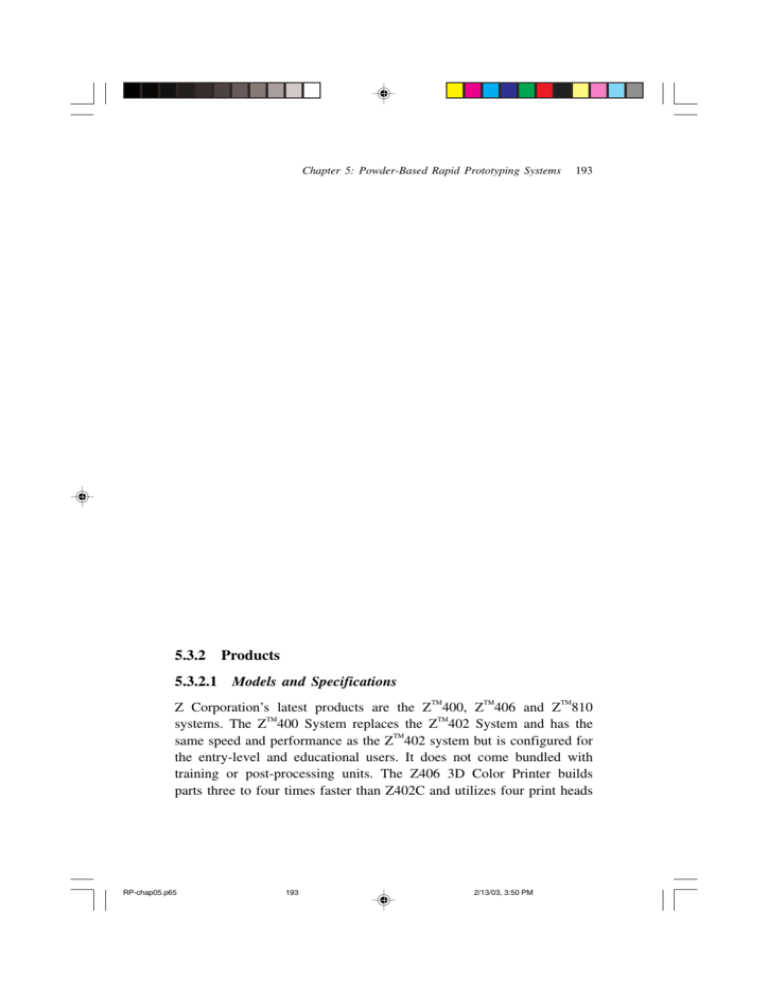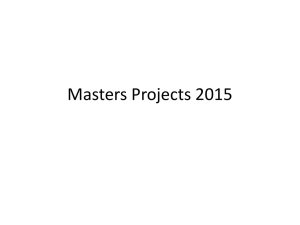5.3.2 Products
advertisement

Chapter 5: Powder-Based Rapid Prototyping Systems 193 5.3.2 Products 5.3.2.1 Models and Specifications TM TM TM Z Corporation’s latest products are the Z 400, Z 406 and Z 810 TM TM systems. The Z 400 System replaces the Z 402 System and has the TM same speed and performance as the Z 402 system but is configured for the entry-level and educational users. It does not come bundled with training or post-processing units. The Z406 3D Color Printer builds parts three to four times faster than Z402C and utilizes four print heads RP-chap05.p65 193 2/13/03, 3:50 PM 194 Rapid Prototyping: Principles and Applications Table 5.3: Specifications of Z Corporation’s 3D Printers Model Build speed TM TM Z 400 3DP TM Z 406 3DP 2 layers / min Z 810 3DP Color: 2 layers / min Monochrome: 6 layers / min Build volume (mm × mm × mm) 203 × 254 × 203 203 × 254 × 203 500 × 600 × 400 Layer thickness (mm) 0.076–0.254 0.076–0.254 0.076–0.254 Equipment dimensions (mm × mm × mm) 740 × 910 × 1070 740 × 910 ×1070 1020 × 790 ×1120 Equipment weight (kg) 136 136 210 System software Z Corp.’s proprietary system software runs on Microsoft Windows 2000 and NT. VRML, ZCP, PLY and SFX file formats can be used for color input. STL file format is accepted for monochrome parts. Materials Starch and plaster formulations. as compared to Z402C. Its new print heads were developed by Hewlett Packard. This new machine is the first product of a cross-licensing agreement between HP and Z Corporation in the field of 3D printing. ZTM810 System’s large build volume and inexpensive build materials make it the fastest and the least expensive way to create large appearance prototypes. The system also offers a variety of finishing options including epoxy infiltration, sanding, painting and plating. The option of color gives the user added information and aesthetics through the ability to incorporate color directly into the part as it is being printed [13]. Table 5.3 shows the specifications of Z Corporation’s 3D printers. The Z400 3D printer is the entry-level concept modeling solution that delivers great models quickly and inexpensively. Models can be used for design verification, communication and as patterns for casting applications. Z Corporation offers a variety of materials for use with the RP-chap05.p65 194 2/13/03, 3:50 PM Chapter 5: Powder-Based Rapid Prototyping Systems 195 TM Figure 5.11: Z 406 3D printer Z400 3D printer. Beginning with two basic materials, a versatile and inexpensive starch-based powder and a high-definition plaster-based powder, infiltrants can also be added to satisfy a wide range of modeling needs. The Z406 System is a premium 3D Printer with the capability of printing in full-color, communicating important information about parts, including engineering data, labeling, highlighting and appearance simulation. It can print in six million colors and uses a new pigment system developed by Cabot Corporation for fuller and brighter colors. The software interface included with the new machine, MAGICS Z allows users to add color information to STL files. It also includes a labeling option that lets users add text such as dates or revision coding directly to STL files. Figure 5.11 shows a photograph of Z TM Corporation’s Z 406 3D printer. The Z810 System is the fastest and the least expensive way to create large appearance prototypes for design review, mock-ups for form and fit testing, and patterns for casting applications. The large build volume allows full-scale concept models to be made for more effective communication with marketing, manufacturing, customers and suppliers. The Z810 System’s color capability allows accurate representation of designs including FEA and other engineering data, further enhancing communication. Physical models can be created in plaster or starch-based materials and can be infiltrated to produce RP-chap05.p65 195 2/13/03, 3:50 PM 196 Rapid Prototyping: Principles and Applications parts with a variety of material properties, satisfying a wide spectrum of modeling needs. Z Corporation also has an accessory, the ZW4 Automated Waxer, for use with the 3D printers. The ZW4 Waxer allows printed parts to be infiltrated with paraffin wax to enhance strength, provide uniform part finish and color, or to create patterns suitable for investment casting. 5.3.2.2 Advantages (1) High speed. Fastest 3D printer to date. Each layer is printed in seconds, reducing the prototyping time of a hand-held part to 1 to 2 hours. (2) Versatile. Parts are currently used for the automotive, packaging, education, footwear, medical, aerospace and telecommunications industries. Parts are used in every step of the design process for communication, design review and limited functional testing. Parts can be infiltrated if necessary, offering the opportunity to produce parts with a variety of material properties to serve a range of modeling requirements. (3) Simple to operate. The office compatible Zcorp system is straightforward to operate and does not require a designated technician to build a part. The system is based on the standard, off the shelf components developed for the ink-jet printer industry, resulting in a reliable and dependable 3D printer. (4) No wastage of materials. Powder that is not printed during the cycle can be reused. (5) Color. Enables complex color schemes in RP-ed parts from a full 24-bit palette of colors. 5.3.2.3 Disadvantages (1) Limited functional parts. Relative to the SLS, parts built are much weaker, thereby limiting the functional testing capabilities. (2) Limited materials. The materials available are only starch and plaster-based materials, with the added option to infiltrate wax using the ZW4 Waxer. RP-chap05.p65 196 2/13/03, 3:50 PM Chapter 5: Powder-Based Rapid Prototyping Systems 197 (3) Poor surface finish. Parts built by 3D printing have a relatively poorer surface finish and post-processing is frequently required. 5.3.3 Process [14] (1) The machine spreads a layer of powder from the feed box to cover the surface of the build piston. The printer then prints binder solution onto the loose powder, forming the first cross-section. For monochrome parts, Z406 color printer uses all four print heads to print a single-colored binder. For multi-colored parts, each of the four print heads deposits a different color binder, mixing the four color binders to produce a spectrum of colors that can be applied to different regions of a part. (2) The powder is glued together at where the binder is printed. The remaining powder remains loose and supports the layers that will be printed above. (3) When the cross-section is completed, the build piston is lowered, a new layer of powder is spread over its surface, and the process is repeated. The part grows layer by layer in the build piston until the part is completed, completely surrounded and covered by loose powder. Finally the build piston is raised and the loose powder is vacuumed, revealing the complete part. (4) Once a build is completed, the excess powder is vacuumed and the parts are lifted from the bed. Once removed, parts can be finished in a variety of ways to suit your needs. For a quick design review, parts can be left raw or “green.” To quickly produce a more robust model, parts can be dipped in wax. For a robust model that can be sanded, finished and painted, the part can be infiltrated with a resin or urethane. 5.3.4 5.3.4.1 Examples Sports Shoe Industry The 3D printer has been used by designers, marketers, manufacturers, and managers in the footwear industry. Leading athletic shoe RP-chap05.p65 197 2/13/03, 3:50 PM 198 Rapid Prototyping: Principles and Applications Figure 5.12: Sports shoe design model created by Z Corporation system (Courtesy of Z Corporation) companies, such as Adidas, have used this RP system to radically reduce prototype development time and communicate in new ways [15]. Shoe industries these days are faced with constantly changing consumer preferences and have to react quickly to stay ahead of the business. With the 3D printer, lead times are drastically reduced, beating the competition to the shelves with the latest design trends whilst avoiding an excess inventory of unwanted designs. 5.3.4.2 Javelin Puts Computer Sculpting in the Artist’s Hands Javelin uses the Z402 System to produce computer-sculpted models to assist artists with complex modeling. Parts produced find applications with computer gamers, animators, pre-Hollywood mock-ups designers, and sculpturing artists. The low cost associated with 3DP parts allows several iterations to be used to accelerate the sculpting process. In one instance, CT scan data and Velocity2 software were used to recreate a dinosaur skull. They found that eliminating the need for support structure in a file that exceeds 4 000 000 polygons was a great asset. The CAD file from Velocity2 was sent to the Z402 System and the “dino-head” (shown in Figure 5.13) was built within 7 hours [16]. RP-chap05.p65 198 2/13/03, 3:50 PM Chapter 5: Powder-Based Rapid Prototyping Systems 199 Figure 5.13: “Dino-head” produced by Javelin using the Z Corporation System (Courtesy of Z Corporation) 5.3.5 Research and Development On-going work to improve the versatility of the system in terms of materials, efficiency and software are being carried out to allow new applications. 5.4 5.4.1 OPTOMEC’S LASER ENGINEERED NET SHAPING (LENS) Company Optomec Inc. was incorporated in 1992. Since 1997, Optomec has focused on commercializing a direct fabrication process, the Laser TM Engineered Net Shaping (LENS ) process originally developed by Sandia National Laboratories. Optomec delivered its first commercial system to Ohio State University. The address of Optomec Inc. is 3911 Singer Boulevard, N.E., Albuquerque, NM 87109, USA. RP-chap05.p65 199 2/13/03, 3:50 PM 200 Rapid Prototyping: Principles and Applications 5.4.2 Products 5.4.2.1 Model and Specifications TM TM The latest Optomec’s products are the LENS 750 and LENS 850 systems. These two systems feature the Laser Engineered Net Shaping (LENS) process, a technology that builds or repairs parts using metal powders to form fully dense objects to give excellent material properties. This technique can be used with a wide variety of metals including titanium, tool steels, stainless steels, copper and aluminum. TM TM The LENS 750 and LENS 850 systems contains the following hardware components as in Table 5.4. Table 5.5 shows a summary of the models and specifications of the TM LENS systems. Figure 5.14 shows a photograph of Optomec’s LENS 750 system. 5.4.2.2 Advantages (1) Superior material properties. The LENS process is capable of producing fully dense metal parts [17]. Metal parts produced can also include embedded structures and superior material properties. The microstructure produced is also relatively good. (2) Complex parts. Functional metal parts with complex features are the forte of the LENS system. (3) Reduced post-processing requirements. Post-processing is minimized, thus reducing cycle time. Table 5.4: Hardware components of the LENS systems TM LENS 750 RP-chap05.p65 TM LENS 850 Argon recirculation unit Argon recirculation unit Laser power supply Laser power supply Ante-chamber Ante-chamber Workstation Workstation Process chamber and dri-train Glove box 200 2/13/03, 3:50 PM








